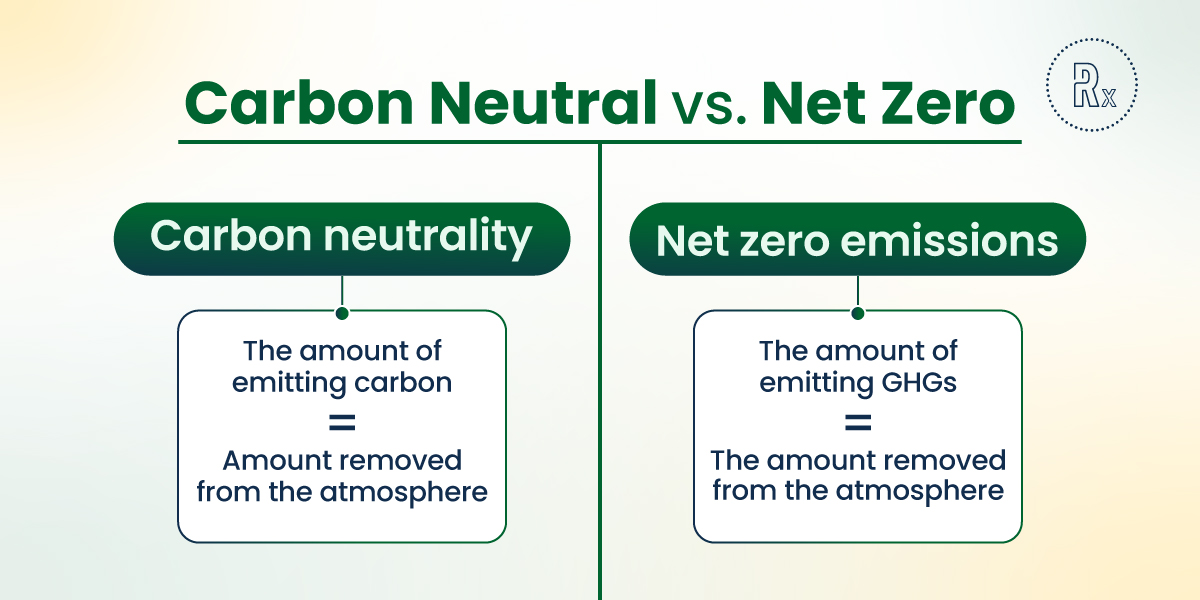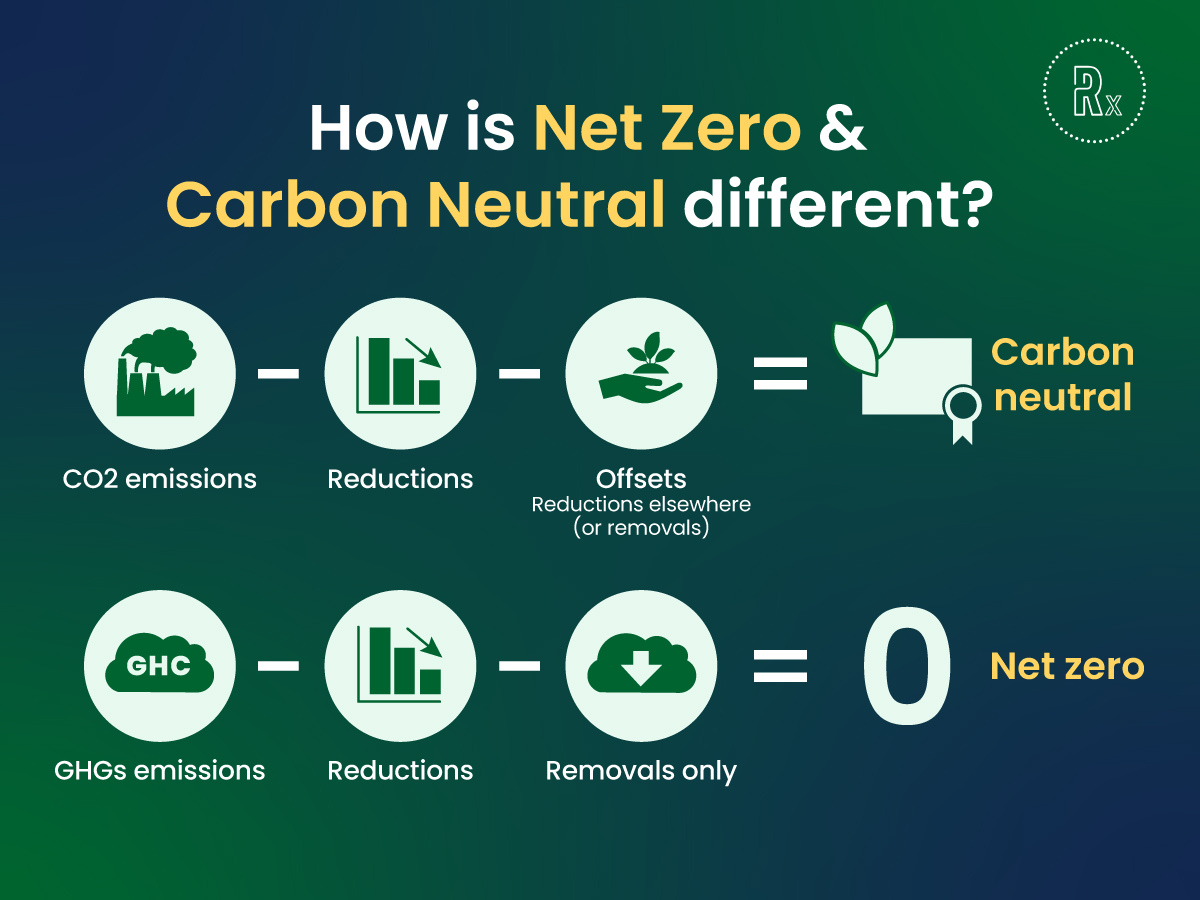As climate change threatens our planet, ‘carbon neutral’ and ‘net zero’ have become key terms in sustainability efforts. Though often used interchangeably, understanding their differences is crucial for effective climate action.
At its core, the journey to either carbon neutrality or net zero involves a deep understanding of greenhouse gases and their effects on global warming. It isn’t just about reducing carbon dioxide (CO2) emissions; it involves a comprehensive approach to managing all greenhouse gas (GHG) emissions, including nitrous oxide and others.
Let’s take a look!
Understanding carbon neutrality
Definition and concept
Carbon neutrality, pursued by various entities including nations and coffee brands, aims to balance carbon emissions with carbon removal. For every ton of carbon emitted, an equivalent amount should be captured or offset. This has led to practices like producing carbon-neutral coffee, ensuring the entire lifecycle results in zero net emissions.
Achieving carbon neutrality involves reducing emissions through methods like using renewable energy and offsetting remaining emissions. Carbon offsetting, a key part of this approach, includes activities such as reforestation and investing in renewable energy projects to remove carbon dioxide from the atmosphere and balance emissions.
How carbon neutrality is achieved
Achieving carbon neutrality begins with accurately measuring carbon footprints. This measurement encompasses all sources of carbon emissions, from direct operational activities to indirect emissions associated with supply chains.
Once the carbon footprint is determined, the next step involves implementing strategies to reduce these emissions. Strategies range from improving energy efficiency, using renewable energy sources, to implementing carbon insetting programs within supply chains.
Carbon insetting, unlike offsetting, involves integrating carbon reduction projects directly within a company’s value chain. This approach not only reduces emissions but also enhances the sustainability of the business model itself. For emissions that cannot be reduced or eliminated, carbon offsetting comes into play. Companies invest in external environmental projects, such as reforestation or renewable energy projects, to balance out their remaining emissions.
The concept of carbon neutrality acknowledges that while completely eliminating emissions may not be immediately feasible for all, there is still a path forward through balancing emissions with equivalent offsets.
Decoding Net Zero emissions
Definition and concept
The term ‘net zero emissions’ refers to a state where the amount of greenhouse gases emitted equals the amount removed from the atmosphere. At its essence, achieving net zero is about balancing the environmental ledger. This doesn’t mean that no emissions are produced; rather, it implies that all emitted greenhouse gases, including carbon dioxide (CO2) and nitrous oxide, are counterbalanced by equivalent emissions reductions or removals.

Net zero carbon (or ‘Carbon Neutrality’), a subset of this broader concept, zeroes in specifically on carbon emissions. It’s a goal that countries and corporations are striving for to tackle global warming.
Strategies for achieving net-zero emissions
Achieving net-zero emissions is a complex and multifaceted challenge that requires a comprehensive and sustained approach. Some of the key strategies include:
- Emissions reductions: The first step towards net zero is reducing current emissions. This can be achieved through various means such as improving energy efficiency, switching to renewable energy sources like wind or solar, and adopting sustainable practices in manufacturing and transportation.
- Carbon offsetting: Carbon offsetting plays a pivotal role in reducing unavoidable emissions. This involves investing in environmental projects that reduce emissions elsewhere, such as reforestation or clean energy projects. Carbon offsetting helps balance emissions, moving closer to the net zero goal.
- Innovative technologies: Technology investment is crucial in the journey to net zero. RegenX, for instance, is developing a proprietary data platform to improve regenerative practices and de-risk financing, effectively contributing to the reduction of greenhouse gas (GHG) emissions.
- Market linkages: Creating market linkages, as done by RegenX, is another strategy. By ensuring farmers have access to markets where they can sell their products at better prices, we incentivize sustainable practices that contribute to net zero emissions.
- Impact measurement: Accurately measuring and reporting on the impact of these efforts, especially in terms of GHG emissions reductions, is vital. This transparency is not only beneficial for stakeholders but also provides valuable data to continuously refine and improve strategies.
Key differences between Carbon Neutrality and Net Zero
While both carbon neutrality and net zero emissions are aimed at combating climate change, they differ in scope, approach, and impact.

A. Scope of emissions covered
Total vs. partial emissions: Net zero emissions focus on eliminating all types of greenhouse gases across all sectors. This approach considers the entire spectrum of emissions, from direct (like those from industrial processes) to indirect (such as those from the electricity used in the production process). In contrast, carbon neutrality often focuses on a narrower set of emissions, sometimes limited to specific activities or products, like carbon neutral coffee.
Carbon insetting vs. offsetting: Net zero emphasizes reducing emissions within the same geographical or organizational boundary, which can be likened to carbon insetting. Carbon neutrality, on the other hand, often relies more on carbon offsetting, where emissions are balanced by funding external projects that reduce GHGs.
B. Short-term vs. long-term goals
Carbon neutrality is often achievable in the short to medium term as it primarily involves offsetting current emissions through various mechanisms such as planting trees or investing in renewable energy projects. This approach allows entities to act swiftly and see immediate results in their sustainability efforts. For instance, a company might achieve carbon neutrality within a year by purchasing enough carbon credits.
In contrast, achieving net zero is a more prolonged endeavor, typically set as a long-term goal. It requires substantial systemic changes, such as overhauling energy systems to rely entirely on renewable sources or reimagining industrial processes to be emission-free. These transformations take considerable time, often spanning decades, but their impact is far more enduring and profound.
C. Individual vs. systemic responsibility
Carbon neutrality often allows entities to take individualized responsibility. Companies, for instance, can calculate their specific emissions and purchase offsets accordingly. This approach can be tailored to fit various scales, from small businesses to large corporations, providing a flexible path to sustainability.
Net zero, by its nature, demands a more collective and systemic approach. It goes beyond individual actions, requiring changes at the policy, industry, and societal levels. Governments and large organizations play a crucial role in leading the way, creating frameworks, and setting regulations that drive the broader shift towards net zero. This level of accountability means not just balancing the books but transforming the entire economic and social systems to be more sustainable.
D. Effectiveness and sustainability
Carbon neutrality, while effective in balancing emissions in the short term, might not always address the root causes of carbon emissions. It’s a vital step, but it sometimes risks creating a ‘business as usual’ scenario where emissions continue, albeit offset. This approach is beneficial for immediate impact but may not be sustainable in the long run without further action to reduce emissions at the source.
Net zero, on the other hand, is inherently more sustainable as it aims to completely eradicate excess emissions over time. It’s a holistic approach that not only addresses current emissions but also works towards reducing future emissions through innovation, policy changes, and societal shifts. The effectiveness of net zero lies in its potential to create lasting change, fundamentally altering how we interact with our environment.
Comparison Table
Aspect | Carbon Neutrality | Net Zero |
Scope | Partial Emissions | Total Emissions |
Strategy | Offsetting | Insetting & Reduction |
Timeframe | Short to Medium Term | Long Term |
Accountability | Individualized | Systemic |
Sustainability | Immediate Impact | Long-term Solution |
Embracing sustainability with RegenX
In summary, understanding the nuances of carbon neutrality and net zero emissions is pivotal in shaping effective climate strategies. While each approach has its unique strengths, they collectively contribute to a broader goal of environmental sustainability.
RegenX can actively play a role in your business journey toward Net Zero. Through our commitment to regenerative agriculture by creating a financing funnel as well as technology support, RegenX offers a pathway to foster the adoption of regenerative farming across Asia, starting with coffee farms in Vietnam.



